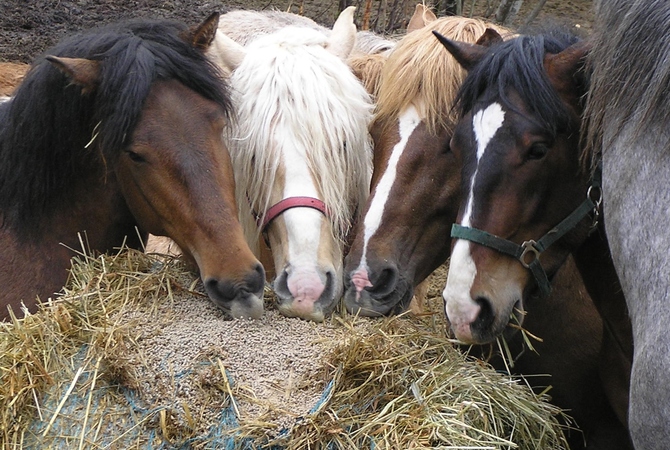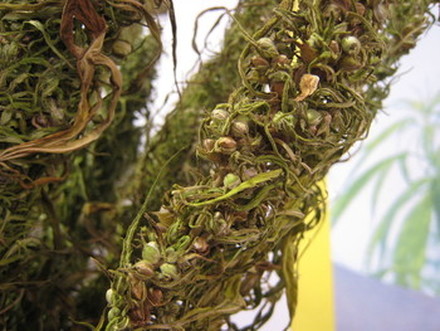
by Juliet M. Getty, Ph.D.
The ingredients tag on your commercial feed says it all. Protein source? Likely, soybeans. Fat source? Likely, soybean oil. But the love affair with soy is starting to fade.
An increasing number of feed manufacturers are coming out with soy-free lines due to consumer demand. There are several reasons for this:
- Many horses seem to be to allergic to soy, exhibiting respiratory, skin and digestive reactions. Some of this may be a legitimate allergic response to allergens found in soy or it could have nothing to do with allergies and may be related to GMO soy. Most soy grown in the US is genetically modified, which has been implicated for variety of health issues. Discussion about this is beyond the scope of this article but suffice it to say, that if you are going to feed soy, it is best to find a non-GMO, and preferably organic source.[i]
- It is difficult to ascertain from a feed label if the soy product has been heat-treated (necessary for inactivating trypsin inhibitor found in raw soybeans). Trypsin inhibitor reduces protein digestion.
- Soy contains significant levels of isoflavones, a type of phytoestrogen, which may mimic estrogen in the body and influence behavior, affect breeding, or interact with other hormones.
- Soybean oil is very high in linoleic acid, an omega 6 fatty acid. Some linoleic acid is required because it is classified as essential, meaning the horse cannot produce it. But too much, relative to alpha linolenic acid (ALA), an essential omega 3 fatty acid, will increase inflammation throughout the body. Since soybean oil has approximately eight times more linoleic acid than ALA, it can lead to health issues relating to joints, digestive tract, hooves, eyes, skin, lungs, and even the brain.
Why is soy so popular?
It has one truly worthwhile characteristic. Its protein content is of high quality. Protein found in other plants such as grass hay, is of low quality. This simply means that the amino acids found in hay are not present in adequate proportion to one another, making it difficult for your horse to have enough amino acids to maintain health.
There are 10 amino acids (out of approximately 20) that must be in your horse’s diet (listed in Table 1). These are referred to as essential amino acids (EAAs) because his body is not capable of producing them or cannot produce them in adequate quantity to meet his needs.
Most feeds contain some protein, and therefore, some EAAs, but if any EAAs are present in low amounts, they limit the extent to which the others can be utilized, resulting in leftover amino acids. And, unfortunately, amino acids cannot be stored for later use. Instead, they are dismantled within the liver into two components – an organic acid and ammonia. Ammonia is converted to urea and excreted in the urine. The organic portion can contribute to excess calories and even glucose production.[ii]
Your goal is to feed a full spectrum of amino acids, so your horse does not destroy many of them, and instead, utilizes them to build and repair body tissues. Since horses are herbivores, they rely on a variety of plant protein sources to accomplish this. Adding soy to the diet has provided a concentrated source of protein that is inexpensive and easy to feed.

But, there’s a new choice, a better choice… hemp seeds.
No, it is not marijuana. They are both part of the Cannabis family. But they are different subspecies. Marijuana is selectively bred to contain high amounts of psychoactive THC. Hemp seeds, on the other hand, are very low in THC (less than 4 ppm). Another phytocannabinoid, known as cannabidiol (CBD) is gaining interest in the health industry. It does not have any intoxicating properties and is found in low quantities in hemp seeds (less than 0.4%).[iii]
Hemp seeds rival soy in protein quality
Hemp seeds are amazingly nutritious. As a protein source, they offer all 10 essential amino acids, in their proper proportion, exceeding soy in protein quality!
Their two main proteins are albumin and edestin, both of which have significant amounts of all EAAs. They are comparable to soybeans’ protein content and in many cases, exceed the EAA content of the animal protein, whey (found in milk), as shown in Table 1.
|
Table 1: Essential Amino Acid (EAA) Comparison between Hemp seeds, Soybeans, and Whey (grams per 100g)[iv] |
|||
|
EAA |
Hemp seeds |
Soybeans |
Whey |
|
Methionine |
0.58 |
0.53 |
0.23 |
|
Arginine |
3.10 |
2.14 |
0.39 |
|
Threonine |
0.88 |
1.35 |
1.02 |
|
Tryptophan |
0.20 |
0.41 |
0.25 |
|
Histidine |
0.71 |
0.76 |
0.29 |
|
Isoleucine |
0.98 |
1.62 |
0.85 |
|
Leucine |
1.72 |
2.58 |
1.40 |
|
Lysine |
1.03 |
1.73 |
1.15 |
|
Valine |
1.28 |
1.60 |
0.91 |
|
Phenylalanine |
1.17 |
1.78 |
0.49 |
What’s even more impressive, however, is the percent of each EAA to the lysine level – a true measure of protein quality. With horses, quality is determined by comparing each EAA to lysine as it would ideally exist in muscle[v]. Lysine is assigned a value of 100. Hemp seed and soybean values were calculated by dividing each EAA level by its lysine level (1.03 for Hemp seeds; 1.73 for Soybeans; shown in Table 1)
The ideal values are shown in Table 2, which reveals how every EAA found in hemp seeds surpasses the ideal percentage beyond soybean’s ability.
|
Table 2: Percent of EAA to Lysine, Compared to Ideals |
|||
|
EAA |
Hemp seeds |
Soybeans |
IDEAL |
|
Methionine |
56 |
31 |
27 |
|
Arginine |
301 |
124 |
76 |
|
Threonine |
85 |
78 |
61 |
|
Tryptophan |
n/a |
n/a |
n/a |
|
Histidine |
69 |
44 |
58 |
|
Isoleucine |
95 |
94 |
55 |
|
Leucine |
167 |
149 |
107 |
|
Lysine |
100 |
100 |
100 |
|
Valine |
124 |
92 |
62 |
|
Phenylalanine |
114 |
103 |
60 |
Hemp seeds contain essential fatty acids with two extra surprises
Both linoleic acid and ALA are found in hemp seeds. Their ratio is 3:1 linoleic (omega 6) to ALA (omega 3). While more omega 3s than 6s would better simulate the ratios found in healthy pasture, hemp seeds along with another source of fat such as ground flaxseeds or chia seeds, are an amazingly nutritious addition to the diet because of the other fatty acids they contain.
There are two types of fat in hemp seeds that you won’t find in significant quantity elsewhere:
- Gamma linolenic acid (GLA) – this belongs to the omega 6 family, but unlike linoleic acid, it reduces inflammation rather than promoting it.
- Stearidonic acid (omega 3) -- this is a precursor to longer chain omega 3s, DHA and EPA, found in fish oils and significantly reduce inflammation.
Other benefits of hemp seeds
- No enzymes inhibitors and can be eaten raw
- Easy to digest
- Highly palatable and great for the picky eater
- Great source of vitamins and minerals including vitamin E
Hempseeds can be fed ground or hulled. For a full-sized horse, the typical dose is ½ to 2 cups per day depending on the horse’s condition and energy needs. If your horse is overweight, you can feed hempseed protein fiber, which has less fat than hempseed products containing more of the seeds. For horses requiring more energy or those who need to gain weight, hempseed oil or high-fat hemp products, are an excellent way to add more calories.[vi]
Bottom line
Rather than reach for a feed that contains soy, consider feeding basic feed ingredients, proper supplementation, and hemp seeds. Hemp seeds are high in the quality protein and fatty acids your horse needs to maintain and repair healthy tissues. Offering whole foods on a regular basis, such as hemp seeds, gives you another tool in maintaining your horse’s overall health.
By Juliet M. Getty, Ph.D.
See “Non-GMO is Not Necessarily Safe” by Juliet M. Getty http://gettyequinenutrition.biz/library/nongmoisnotnecessarilysafe.htm
For more discussion on how excess protein contributes to glucose production, see “Alfalfa and the Insulin Resistant Horse,” Alfalfa and the Insulin Resistant Horse
CBD oil is derived from the flowers, stalks and leaves of the hemp plant, rather than the seeds.
Callaway, J.C. 2004. Hempseed as a nutritional resource: An overview. Euphytica, 140. Pages 65-72. Printed in the Netherlands.
National Research Council. 2007. Proteins and amino acids. Nutrient Requirements of Horses, Sixth Revised Edition. Washington, D.C.: The National Academies Press. Pages 64-65.
Dr. Getty’s Free Shipping store offers a variety of hemp products. http://horsesupplements.gettyequinenutrition.biz
Juliet M. Getty, Ph.D. is an independent equine nutritionist with a wide U.S. and international following. Her research-based approach optimizes equine health by aligning physiology and instincts with correct feeding and nutrition practices. Dr. Getty’s goal is to empower the horseperson with the confidence and knowledge to provide the best nutrition for his or her horse’s needs.
Dr. Getty’s fundamental resource book, Feed Your Horse Like a Horse, is available in paperback as well as in hardcover and Kindle versions. All except the Kindle version are available at www.GettyEquineNutrition.com -- buy the book there and have it inscribed by the author. Print and Kindle versions are also available at Amazon (www.Amazon.com); find print versions at other online retail bookstores. The seven individual volumes in Dr. Getty’s topic-centered “Spotlight on Equine Nutrition” series are available with special package pricing at her website, and also at Amazon in print and Kindle versions. Dr. Getty’s books make ideal gifts for equestrians!
Find a world of useful information for the horseperson at www.GettyEquineNutrition.com: Sign up for Dr. Getty’s informative, free e-newsletter, Forage for Thought; browse her library of reference articles; search her nutrition forum archives; and purchase recordings of her educational teleseminars and interviews. Find top-quality supplements, feeders, and other equine-related items, at her online Free Shipping Supplement Store Reach Dr. Getty directly at gettyequinenutrition@gmail.com.
Getty Equine Nutrition is also included on our Supplements page!
About the Author
Juliet M. Getty, Ph.D. is a specialist in equine nutrition whose philosophy is founded on feeding a horse in sync with his natural needs and instincts. Dr. Getty is the author of the comprehensive resource, Feed Your Horse Like A Horse, and her articles and interviews often appear in national and international publications.
You can more interesting articles in our section on Health & Education.

































